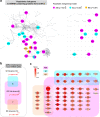Roles and mechanisms of ankyrin-G in neuropsychiatric disorders
- PMID: 35794211
- PMCID: PMC9356056
- DOI: 10.1038/s12276-022-00798-w
Roles and mechanisms of ankyrin-G in neuropsychiatric disorders
Abstract
Ankyrin proteins act as molecular scaffolds and play an essential role in regulating cellular functions. Recent evidence has implicated the ANK3 gene, encoding ankyrin-G, in bipolar disorder (BD), schizophrenia (SZ), and autism spectrum disorder (ASD). Within neurons, ankyrin-G plays an important role in localizing proteins to the axon initial segment and nodes of Ranvier or to the dendritic shaft and spines. In this review, we describe the expression patterns of ankyrin-G isoforms, which vary according to the stage of brain development, and consider their functional differences. Furthermore, we discuss how posttranslational modifications of ankyrin-G affect its protein expression, interactions, and subcellular localization. Understanding these mechanisms leads us to elucidate potential pathways of pathogenesis in neurodevelopmental and psychiatric disorders, including BD, SZ, and ASD, which are caused by rare pathogenic mutations or changes in the expression levels of ankyrin-G in the brain.
© 2022. The Author(s).
Conflict of interest statement
The authors declare no competing interests.
Figures




Similar articles
-
Ankyrin-G regulates forebrain connectivity and network synchronization via interaction with GABARAP.Mol Psychiatry. 2020 Nov;25(11):2800-2817. doi: 10.1038/s41380-018-0308-x. Epub 2018 Nov 30. Mol Psychiatry. 2020. PMID: 30504823 Free PMC article.
-
Ankyrins: Roles in synaptic biology and pathology.Mol Cell Neurosci. 2018 Sep;91:131-139. doi: 10.1016/j.mcn.2018.04.010. Epub 2018 May 3. Mol Cell Neurosci. 2018. PMID: 29730177 Free PMC article. Review.
-
Clinical case report: mosaic ANK3 pathogenic variant in a patient with autism spectrum disorder and neurodevelopmental delay.Cold Spring Harb Mol Case Stud. 2023 Jul 11;9(3):a006233. doi: 10.1101/mcs.a006233. Print 2023 Jun. Cold Spring Harb Mol Case Stud. 2023. PMID: 37263801 Free PMC article.
-
Ankyrin 3: genetic association with bipolar disorder and relevance to disease pathophysiology.Biol Mood Anxiety Disord. 2012 Oct 1;2:18. doi: 10.1186/2045-5380-2-18. Biol Mood Anxiety Disord. 2012. PMID: 23025490 Free PMC article.
-
Physiological roles of axonal ankyrins in survival of premyelinated axons and localization of voltage-gated sodium channels.J Neurocytol. 1999 Apr-May;28(4-5):303-18. doi: 10.1023/a:1007005528505. J Neurocytol. 1999. PMID: 10739573 Review.
Cited by
-
Investigating the impact of severe maternal SARS-CoV-2 infection on infant DNA methylation and neurodevelopment.Mol Psychiatry. 2024 Oct 30. doi: 10.1038/s41380-024-02808-x. Online ahead of print. Mol Psychiatry. 2024. PMID: 39478169
-
The phenotypic and genotypic spectrum of individuals with mono- or biallelic ANK3 variants.Clin Genet. 2024 Nov;106(5):574-584. doi: 10.1111/cge.14587. Epub 2024 Jul 11. Clin Genet. 2024. PMID: 38988293
-
ANK3 rs10994336 and ZNF804A rs7597593 polymorphisms: genetic interaction for emotional and behavioral symptoms of alcohol withdrawal syndrome.BMC Psychiatry. 2024 May 3;24(1):335. doi: 10.1186/s12888-024-05787-z. BMC Psychiatry. 2024. PMID: 38702695 Free PMC article.
-
A characteristic cerebellar biosignature for bipolar disorder, identified with fully automatic machine learning.IBRO Neurosci Rep. 2023 Jul 1;15:77-89. doi: 10.1016/j.ibneur.2023.06.008. eCollection 2023 Dec. IBRO Neurosci Rep. 2023. PMID: 38025660 Free PMC article.
-
Overlap in synaptic neurological condition susceptibility pathways and the neural pannexin 1 interactome revealed by bioinformatics analyses.Channels (Austin). 2023 Dec;17(1):2253102. doi: 10.1080/19336950.2023.2253102. Epub 2023 Oct 8. Channels (Austin). 2023. PMID: 37807670 Free PMC article.


